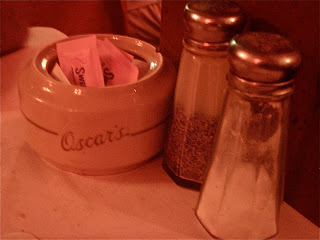Faux-dora
By now, you may have heard that the Fedora restaurant will be closing on July 25 and that it will be renovated and turned into a "casual elegant supper club” by successful restaurateur Gabe Stulman, who spoke of his intentions to "keep most of the cherished design details, along with the name, of the restaurant intact."
Grub Street reports that Stulman said he will "restore Fedora to what it looked like in the thirties and forties." But Fedora didn't open until 1952.

Still, as Grub Street said, "fauxstalgia joints are tres chic these days," referring to a recent New York Times piece about how "a pride of reincarnated restaurants," including the Minetta Tavern and Waverly Inn, have helped turn the Village into "a theme park of the past" complete with "a vision of a lost bohemian New York--albeit with a well-heeled clientele and prices to match."

Will this be another example of theme-parking the past? We've seen it happen not only to restaurants but to Vesuvio Bakery and CBGB. More and more, beloved icons of the city are getting their guts ripped out for revamping, given over to the wealthy, made exclusive, though the husks are kept intact for the cultural cachet they bring to the new owners, who pride themselves on their dedication to preservation, and receive praise for saving the old holes in the wall from turning into banks.

The history at Fedora is significant. On the walls are photos of the men, mostly gay men of the Stonewall era, who made Fedora their home away from home.
It's the "closest thing I know to going home to Mom, especially if Mom had a sense of camp," said one regular to the Times in 1992.
In 1999, the Times described it perfectly: "Walk into Fedora Restaurant on any given night, for example, and you enter another era. Faded pictures recall bygone days when gay men packed the place on West Fourth Street with laughter, song and the camaraderie that comes from being in a refuge from a hostile world. Today, fewer of the regulars from those days stop in. But there are those who still do, gentlemen of a certain age, some with ascots and walking sticks. Others pop in only occasionally, for nostalgia's sake."

Those of us who are homesick for the old city do need refuge from what has become a hostile world. Fedora is such a refuge--from the cell-phone sleepwalkers, the frat-boy tag teams, the screaming sororities.
What will it be when it becomes the New Faux-dora? Whose home will it be then?

all photos, my flickr
Read my past Fedora coverage:
Fedora Returns
Fedora's Last Days
Grub Street reports that Stulman said he will "restore Fedora to what it looked like in the thirties and forties." But Fedora didn't open until 1952.

Still, as Grub Street said, "fauxstalgia joints are tres chic these days," referring to a recent New York Times piece about how "a pride of reincarnated restaurants," including the Minetta Tavern and Waverly Inn, have helped turn the Village into "a theme park of the past" complete with "a vision of a lost bohemian New York--albeit with a well-heeled clientele and prices to match."

Will this be another example of theme-parking the past? We've seen it happen not only to restaurants but to Vesuvio Bakery and CBGB. More and more, beloved icons of the city are getting their guts ripped out for revamping, given over to the wealthy, made exclusive, though the husks are kept intact for the cultural cachet they bring to the new owners, who pride themselves on their dedication to preservation, and receive praise for saving the old holes in the wall from turning into banks.

The history at Fedora is significant. On the walls are photos of the men, mostly gay men of the Stonewall era, who made Fedora their home away from home.
It's the "closest thing I know to going home to Mom, especially if Mom had a sense of camp," said one regular to the Times in 1992.
In 1999, the Times described it perfectly: "Walk into Fedora Restaurant on any given night, for example, and you enter another era. Faded pictures recall bygone days when gay men packed the place on West Fourth Street with laughter, song and the camaraderie that comes from being in a refuge from a hostile world. Today, fewer of the regulars from those days stop in. But there are those who still do, gentlemen of a certain age, some with ascots and walking sticks. Others pop in only occasionally, for nostalgia's sake."

Those of us who are homesick for the old city do need refuge from what has become a hostile world. Fedora is such a refuge--from the cell-phone sleepwalkers, the frat-boy tag teams, the screaming sororities.
What will it be when it becomes the New Faux-dora? Whose home will it be then?

all photos, my flickr
Read my past Fedora coverage:
Fedora Returns
Fedora's Last Days



Comments
Post a Comment